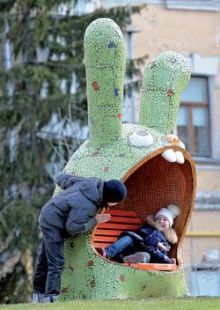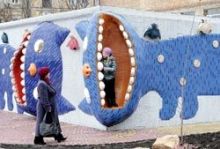I happened to watch the opening of a park that symbolized victory over builders. It was on Peizazhna Alley in Kyiv’s oldest part, right over the legendary village of Honchari-Kozhumiaky (“Potters and Tanners”), already disfigured by architects and builders, practically at the territory of the National Historical Museum, near the foundations of the Tithe Church, the 400-year-old lime tree of Metropolitan Petro Mohyla, the remnants of Princess Olha’s rotunda, and an ancient rampart of the Prince Kyi era.
It is right here that the (not so) highly respected investors planned to build a modern apartment house. This time their plans came unstuck — the public intervened. The struggle lasted for more than one year. Finally, a park came up instead of a construction site at some private persons’ expense.
Investors also failed, as they did a few years ago, to erect a high rise in the park next to 12/14 Bereznialivska St., where residents besieged the builders for about six months and the authorities finally set up one of the Left Bank’s best playgrounds here — contrary to all construction norms (www.telekritika.ua).
There are about 300 “hot spots” in Kyiv, where bitter clashes continue between the builders and the Kyivites who defend their parks, children’s playgrounds, woodlands, islands, and river banks. A victory of residents over builders is an extremely rare thing, so each event of this kind is of paramount importance.
The opening of the park on Peizazhna Alley attracted a lot of good people, such as Borys Oliinyk, Yurii Rybchynsky, Natalia Sumska, Andrii Kurkov, and Oleh Skrypka, but politicians or presidential candidates were conspicuous for their absence. Nor did any Shevchenkivsky raion or Kyiv city administrators show up.
That was a real civic event, which is, unfortunately, not a typical thing now. The people who managed to achieve this were charged with the energy of the Maidan and the belief that the public can resist the authorities’ brazen shamelessness — a belief that is vanishing.
Today it is the crisis that helps the defenders of the city’s historical face. And what about tomorrow? Tomorrow there will be new generations of true Kyivites who will grow up in the parks like the one that recently emerged on Peizazhna Alley.
Kostiantyn SKRETUTSKY, sculptor:
“It was terrible to work at the very beginning. Absolutely no facilities. There were all kinds of unexpected situations. I sometimes thought this project would remain a non-starter. But soon, as we were gaining experience, things were better, easier, and faster. We first worked openly, but this created too many problems with electricity, neighbors, city authorities, etc.
Some people reacted quite peculiarly: just fancy that! You did not ask for permission to do this! Those were ordinary people who do not even hold administrative offices. Such unpleasantries occur less and less often. As for the like-minded people and professional colleagues, I will name the sculptor Volodymyr Bilokon. But we have not yet worked together. I would say our tastes differ a little. But the point is that the organization of collective projects depends not so much on the existence of like-minded people as on the financial potential of the organizers. So far, the organizer of my work can afford me alone. But it would be a good idea to hold, say, a competition. Of course, this requires a considerable injection of money. I would be very glad if more people were gentrifying the city in various manners. If our Kyiv receives more things like this, people will become merrier and the city cleaner. Accordingly, you will be more pleased to stay in it.”
Andrii KURKOV, writer:
“I am taking a very positive view of this initiative. My children just adore this place and are ready to visit it every day. It is a real treat to sit on these huge sculptures and get into the maw of a cat. I think it is the best sculptural complex in Kyiv. Such initiatives, actions, and artworks are one of the few examples of how one can and must save green parks from aggressive builders. They planned to erect a nine-storied building for the Foreign Ministry at this place on Peizazhna Alley. We are making every effort now to have Kyiv’s official park status granted to this green island.”
Volodymyr KOLINKO, vice-president, Kyiv Landscape Initiative; art patron:
“People are very much tired of the incessant defeats of a civic stand. In Kyiv alone, there have been a lot of protests but victories can be counted on the fingers of one hand. People are tired of always being on the receiving end. So they usually turn in on themselves and take an indifferent attitude: ‘We won’t make it anyway.’
“A civic stand encounters the resistance of the entire bureaucratic machine, all the builders’ money, and courts of law. Any victory, even of a local nature, shows that, firstly, something can be done differently, but this requires time and effort. Secondly, I think there are a sufficient number of people in Kyiv, who are financially and psychologically prepared for action, but they need to be shown an example. So I believe that two or three more high-profile precedents like this will gradually cause the situation to change.
“Bureaucrats are saying: we must only develop like this, i.e., go higher and build more square meters, which means a place to live in and more jobs — and all the rest is trifles. But it is still a moot point what this construction is actually for. Perhaps for people to live better? But what does ‘better’ mean? It means that people should feel comfortable and protected and take pleasure in going out on the street.
“As a true participant in the Orange Revolution, I will say that many do not understand a simple thing: people were standing up for themselves. That was the first manifestation of a civic position. And if the same thing occurred, I would do the same again. So I think the Orange Revolution gave a powerful impetus to many things in various fields. One should understand that it was a victory for everybody, not a defeat for somebody. This was for everybody’s benefit. It does not matter whether you are rich or poor and where you are now. This is for your children. One cannot build a personal paradise — it is impossible. One can build a personal hell, while paradise can only be one for all.”








